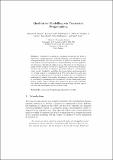Files in this item
Qualitative modelling via constraint programming
Item metadata
| dc.contributor.author | Kelsey, Tom | |
| dc.contributor.author | Kotthoff, Lars | |
| dc.contributor.author | Jefferson, Christopher Anthony | |
| dc.contributor.author | Linton, Stephen Alexander | |
| dc.contributor.author | Miguel, Ian James | |
| dc.contributor.author | Nightingale, Peter | |
| dc.contributor.author | Gent, Ian Philip | |
| dc.date.accessioned | 2019-03-27T12:30:05Z | |
| dc.date.available | 2019-03-27T12:30:05Z | |
| dc.date.issued | 2014-04 | |
| dc.identifier | 105502246 | |
| dc.identifier | 59db640e-cc1a-43fc-b7e6-dd3c2703391d | |
| dc.identifier | 84898818731 | |
| dc.identifier | 000334052400005 | |
| dc.identifier.citation | Kelsey , T , Kotthoff , L , Jefferson , C A , Linton , S A , Miguel , I J , Nightingale , P & Gent , I P 2014 , ' Qualitative modelling via constraint programming ' , Constraints , vol. 19 , no. 2 , pp. 163-173 . https://doi.org/10.1007/s10601-014-9158-6 | en |
| dc.identifier.issn | 1383-7133 | |
| dc.identifier.other | ORCID: /0000-0002-5052-8634/work/34029955 | |
| dc.identifier.other | ORCID: /0000-0002-8091-1458/work/27201541 | |
| dc.identifier.other | ORCID: /0000-0003-2979-5989/work/60887527 | |
| dc.identifier.other | ORCID: /0000-0002-6930-2686/work/68281422 | |
| dc.identifier.uri | https://hdl.handle.net/10023/17386 | |
| dc.description | This work was supported by United Kingdom EPSRC grant EP/H004092/1. LK was supported by EU FP7 grants 284715 (ICON) and 288147 (ePolicy). | en |
| dc.description.abstract | Qualitative modelling is a technique integrating the fields of theoretical computer science, artificial intelligence and the physical and biological sciences. The aim is to be able to model the behaviour of systems without estimating parameter values and fixing the exact quantitative dynamics. Traditional applications are the study of the dynamics of physical and biological systems at a higher level of abstraction than that obtained by estimation of numerical parameter values for a fixed quantitative model. Qualitative modelling has been studied and implemented to varying degrees of sophistication in Petri nets, process calculi and constraint programming. In this paper we reflect on the strengths and weaknesses of existing frameworks, we demonstrate how recent advances in constraint programming can be leveraged to produce high quality qualitative models, and we describe the advances in theory and technology that would be needed to make constraint programming the best option for scientific investigation in the broadest sense. | |
| dc.format.extent | 220432 | |
| dc.language.iso | eng | |
| dc.relation.ispartof | Constraints | en |
| dc.subject | Constraint programming | en |
| dc.subject | Qualitative models | en |
| dc.subject | QA75 Electronic computers. Computer science | en |
| dc.subject | Artificial Intelligence | en |
| dc.subject.lcc | QA75 | en |
| dc.title | Qualitative modelling via constraint programming | en |
| dc.type | Journal article | en |
| dc.contributor.sponsor | EPSRC | en |
| dc.contributor.sponsor | EPSRC | en |
| dc.contributor.institution | University of St Andrews. School of Computer Science | en |
| dc.contributor.institution | University of St Andrews. Centre for Interdisciplinary Research in Computational Algebra | en |
| dc.identifier.doi | 10.1007/s10601-014-9158-6 | |
| dc.description.status | Peer reviewed | en |
| dc.identifier.grantnumber | EP/H004092/1 | en |
| dc.identifier.grantnumber | EP/K015745/1 | en |
This item appears in the following Collection(s)
Items in the St Andrews Research Repository are protected by copyright, with all rights reserved, unless otherwise indicated.

